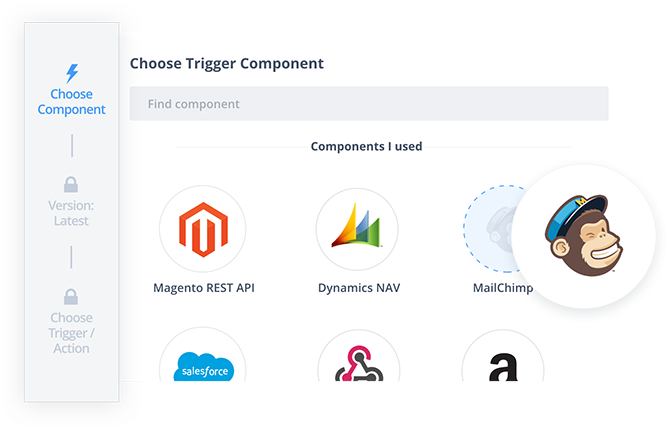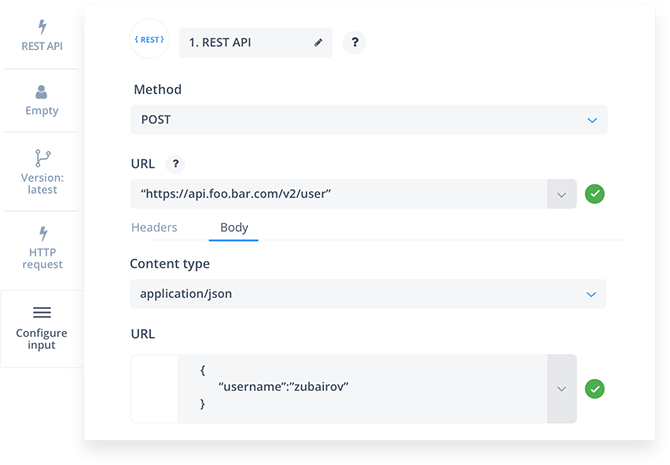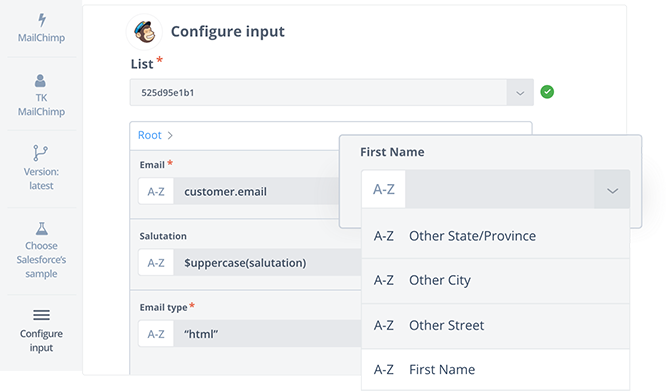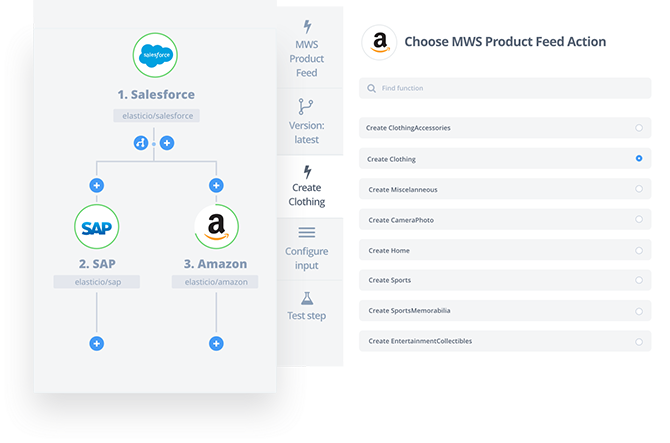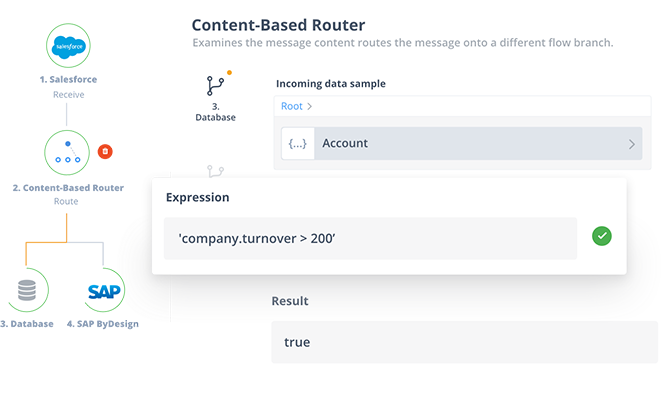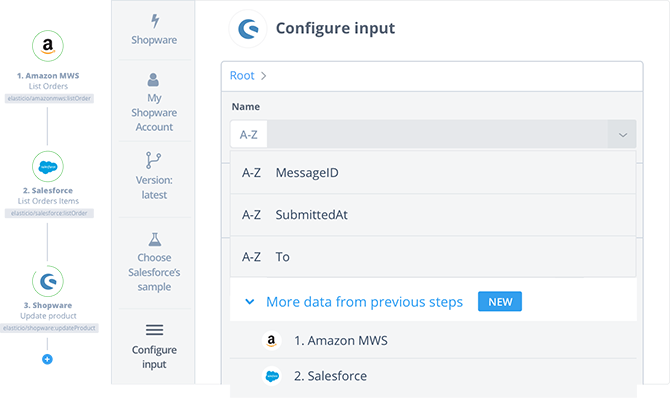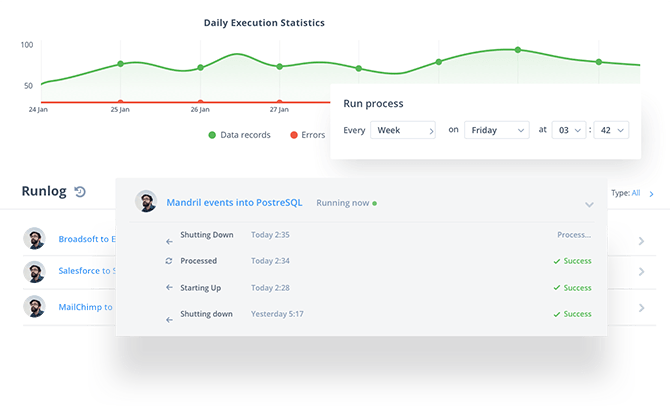Enterprise Integration
Platform
Establish a truly connected enterprise by leveraging the power of a cloud-native, low-code enterprise integration platform

With the elastic.io easy-to-use and powerful Enterprise Integration Platform, you can have the advantages offered by B2B gateways, API management and ESB solutions all in one tool
Powerful workflow automation and data transformation tools
Process automation is key to reducing time spent on transforming different data formats and speeding up the ETL job creation processes. The intuitive visual designer and iPaaS workflow builder together with pre-built connectors accelerate time-to-market of business process digitization and makes it simple for ad-hoc developers as well as integration specialists to connect systems and applications in days, not weeks or months.
Built-in low-code tools for complex transformations, conditional logic, aggregation and splitting operations as well as enrichment support all iPaaS integration patterns. Maximize productivity and flexibility of your IT with a state-of-the-art enterprise integration platform capable of processing over 4 million transactions per minute.
Expression Language
Built-in operators and functions for smart extraction and transformation of data
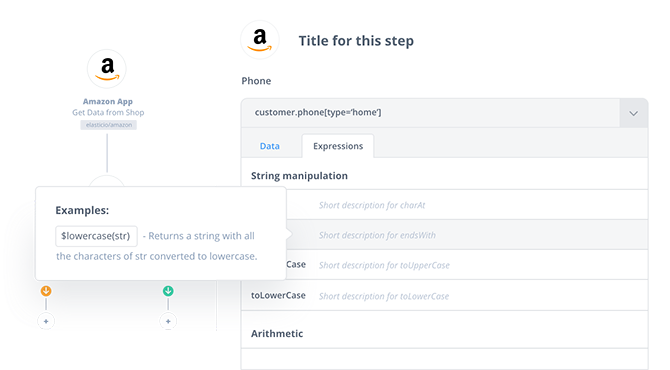
- Smart connectors Over 100 pre-built connectors for mainstream business applications
- Protocol connectors Integrate via standard protocols such as REST, SOAP, ODATA, or via Database
- Mapper Fast and no-code configuration of integration flows
- Expression Language Built-in operators and functions for smart extraction and transformation of data
- Forks Send data from one system to multiple systems and then aggregate it again
- Content-based routing Send a data message to the appropriate system based on the message content
- Content enrichment Map data between non-adjacent integration steps
- Batch and event-based Data is sent to other systems at scheduled intervals or in real-time mode
Comprehensive monitoring and debugging mechanisms
From the runlog in daily execution statistics to Logs overview filterable by workflow name, date and error level, the elastic.io Enterprise Integration Platform comes with all the necessary tools to detect and alert to inconsistencies, find the source of errors and fix rebelling workflows within one or two hours. Additional features include retry from a single flow step and custom error handler within each single workflow. A robust monitoring system to insure 99,99-percent uptime.
dashboard
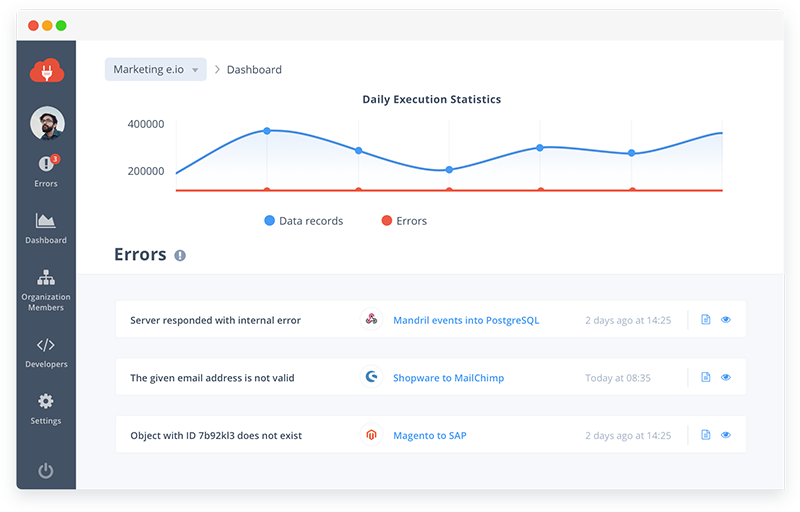
logging
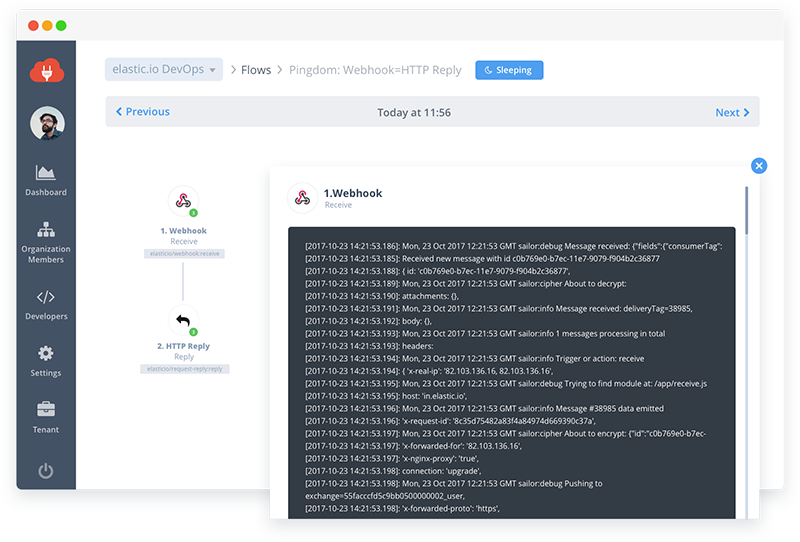
error-handling
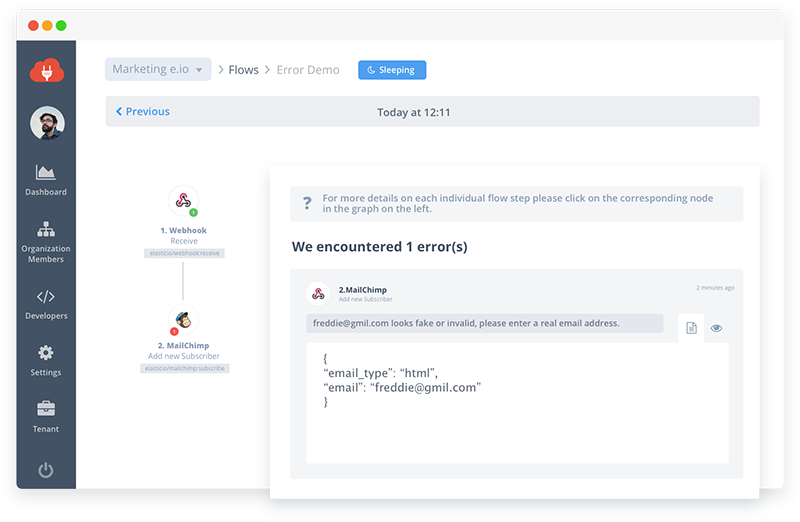
Single enterprise integration platform for any architecture
The value of an enterprise integration tool is directly proportional to its ability to support a wide range of scenarios and future-proof your digital transformation strategy. The elastic.io enterprise integration platform is not only an ideal fit for cloud applications by its very nature, but it can also provide secure access to datasets residing in local databases and legacy systems via the VPN Agent, connect private and public clouds, or act as a middleware between multiple clouds and on-premises altogether.
Public cloud

Private cloud

Hybrid cloud

Multi cloud

All development tools a data integrator can wish for
Agility and flexibility don’t need to come at a price of security and governance. Multi-level environment management with granular user roles and permissions ensure efficient yet safe collaboration across the entire organization, from Line of Business users to IT specialists, or even B2B customers and partners.
Moreover, the platform is easily extensible, ensuring fast development of new components with minimal efforts, and provides an ideal playground for building new products and services on top.
sdk
1
2
3
4
5
6
7
8
9
10
11
12
13
14
15
16
17
18
19
20
21
22
23
const request = require ('request-promise');
/**
* This method will be called from elastic.io with following parameteers
*
* @param msg incoming message object that contains https://api.github.com/users/${msg.body.user}?length=${cfg.pageSize});
const repos = await request.get (user.repos_url);
console.log (Fetched ${repos.length} repos);
return { repos };
}
module.exports.process = process;
public class CreateCustomerAction implements Module {
private static final Logger logger = LoggerFactory.getLogger(CreateCustomerAction
.class) ;
@Override
public final void execute (ExecutionParameters parameters) {
// This is an incoming message
final Message message = parameters.getMessage() ;
logger.info("Received message {}", message) ;
// This is outgoing result
final JsonObject body = Json.createObjectBuilder()
.add("message", "hello world")
.build() ;
final Message data = new Message.Builder().body(body).build() ;
// Sending it to the next integration step
parameters.getEventEmitter().emitData(data) ;
}
}
Coming soon.
integration management api
1
2
3
4
5
6
7
8
9
10
11
12
13
14
15
16
17
18
19
20
21
22
23
24
25
26
27
28
29
30
31
32
33
34
35
36
37
38
39
40
41
curl https://api.elastic.io/v2/flows \
-u {EMAIL}:{APIKEY} \
-H 'Accept: application/json' \
-H 'Content-Type: application/json' -d '
{
"data": {
"type": "flow",
"attributes": {
"name": "Timer to E-Mail",
"type": "ordinary",
"graph": {
"nodes": [
{
"id": "step_1",
"command": "elasticio/timer:timer",
"fields": {
"interval": "minute"
}
},
{
"id": "step_2",
"command": "elasticio/email:send"
}
],
"edges": [
{
"source": "step_1",
"target": "step_2",
"config": {
"mapper": {
"to": "[email protected]",
"subject": "Test",
"textBody": "{{fireTime}}"
}
}
}
]
}
}
}
}'
curl https://api.elastic.io/v2/users \
-X POST \
-u {EMAIL}:{APIKEY} \
-H 'Accept: application/json' \
-H 'Content-Type: application/json' -d '
{
"data": {
"type": "user",
"attributes": {
"first_name": "John",
"last_name": "Doe",
"email": "[email protected]",
"password": "secret",
"company": "Doe & Partners"
},
"relationships": {
"organizations": {
"data": [
{"id": "54f4be3fe7d5224f91000001"}
]
}
}
}
}'
curl https://api.elastic.io/v2/flows/{FLOW_ID}/start \
-X POST \
-u {EMAIL}:{APIKEY} \
-H 'Accept: application/json' \
-H 'Content-Type: application/json'
- sdk Easily create your own custom connectors following the simple Git flow
- integration management api Fast and no-code configuration of integration flows
Future-proof your integration needs with a single extensible platform
Our integration as a service approach allows both IT specialists and ad-hoc integrators to reduce the number of manual processes and eliminate the need for complex coding. The reusability of components as well as easy component creation powered by our SDKs provides maximum flexibility to address a variety of business requirements now and in the future.
Extend the elastic.io Enterprise Integration Platform with:
#1 Applications such as Salesforce, Microsoft Dynamics 365 / AX / CRM / NAV, NetSuite, SAP, Magento, and many more
#2 Databases such as Google BigQuery, MongoDB, JDBC, MsSQL, PostgreSQL, and Snowflake
#3 Customs connectors built on top REST, SOAP or ODATA and with the help of an intuitive connector builder
#4 elastic.io for Hybrid Integration to securely connect rapidly connect server-less applications with server-based data sources
#5 elastic.io for B2B Integration to connect via traditional B2B protocols and standards such as EDI or XML
#6 ...and so much more: Mobile, IoT, Analytics, Migration – whether there is a need to move and transform data, there is elastic.io
elastic.io enabled us to share data in realtime, across multiple systems based on low-code integrations. The time spent on a single integration decreased while the ability to build new integrations in short time grew exponentially.
Senior Software Architect, Krombacher


